Ajay Mandlekar
ORBIT: A Unified Simulation Framework for Interactive Robot Learning Environments
Jan 10, 2023



Abstract:We present ORBIT, a unified and modular framework for robot learning powered by NVIDIA Isaac Sim. It offers a modular design to easily and efficiently create robotic environments with photo-realistic scenes and fast and accurate rigid and deformable body simulation. With ORBIT, we provide a suite of benchmark tasks of varying difficulty -- from single-stage cabinet opening and cloth folding to multi-stage tasks such as room reorganization. To support working with diverse observations and action spaces, we include fixed-arm and mobile manipulators with different physically-based sensors and motion generators. ORBIT allows training reinforcement learning policies and collecting large demonstration datasets from hand-crafted or expert solutions in a matter of minutes by leveraging GPU-based parallelization. In summary, we offer an open-sourced framework that readily comes with 16 robotic platforms, 4 sensor modalities, 10 motion generators, more than 20 benchmark tasks, and wrappers to 4 learning libraries. With this framework, we aim to support various research areas, including representation learning, reinforcement learning, imitation learning, and task and motion planning. We hope it helps establish interdisciplinary collaborations in these communities, and its modularity makes it easily extensible for more tasks and applications in the future. For videos, documentation, and code: https://isaac-orbit.github.io/.
Active Task Randomization: Learning Visuomotor Skills for Sequential Manipulation by Proposing Feasible and Novel Tasks
Nov 11, 2022



Abstract:Solving real-world sequential manipulation tasks requires robots to have a repertoire of skills applicable to a wide range of circumstances. To acquire such skills using data-driven approaches, we need massive and diverse training data which is often labor-intensive and non-trivial to collect and curate. In this work, we introduce Active Task Randomization (ATR), an approach that learns visuomotor skills for sequential manipulation by automatically creating feasible and novel tasks in simulation. During training, our approach procedurally generates tasks using a graph-based task parameterization. To adaptively estimate the feasibility and novelty of sampled tasks, we develop a relational neural network that maps each task parameter into a compact embedding. We demonstrate that our approach can automatically create suitable tasks for efficiently training the skill policies to handle diverse scenarios with a variety of objects. We evaluate our method on simulated and real-world sequential manipulation tasks by composing the learned skills using a task planner. Compared to baseline methods, the skills learned using our approach consistently achieve better success rates.
MoCoDA: Model-based Counterfactual Data Augmentation
Oct 20, 2022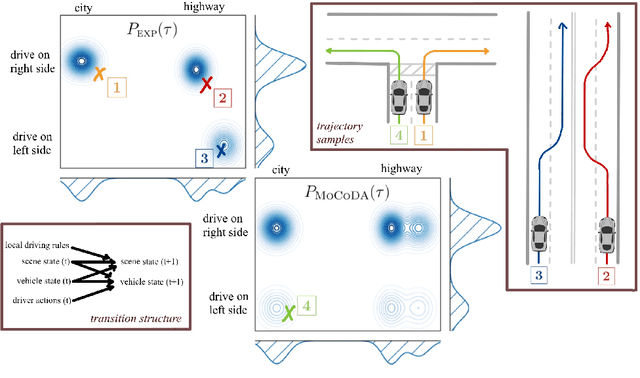



Abstract:The number of states in a dynamic process is exponential in the number of objects, making reinforcement learning (RL) difficult in complex, multi-object domains. For agents to scale to the real world, they will need to react to and reason about unseen combinations of objects. We argue that the ability to recognize and use local factorization in transition dynamics is a key element in unlocking the power of multi-object reasoning. To this end, we show that (1) known local structure in the environment transitions is sufficient for an exponential reduction in the sample complexity of training a dynamics model, and (2) a locally factored dynamics model provably generalizes out-of-distribution to unseen states and actions. Knowing the local structure also allows us to predict which unseen states and actions this dynamics model will generalize to. We propose to leverage these observations in a novel Model-based Counterfactual Data Augmentation (MoCoDA) framework. MoCoDA applies a learned locally factored dynamics model to an augmented distribution of states and actions to generate counterfactual transitions for RL. MoCoDA works with a broader set of local structures than prior work and allows for direct control over the augmented training distribution. We show that MoCoDA enables RL agents to learn policies that generalize to unseen states and actions. We use MoCoDA to train an offline RL agent to solve an out-of-distribution robotics manipulation task on which standard offline RL algorithms fail.
Learning and Retrieval from Prior Data for Skill-based Imitation Learning
Oct 20, 2022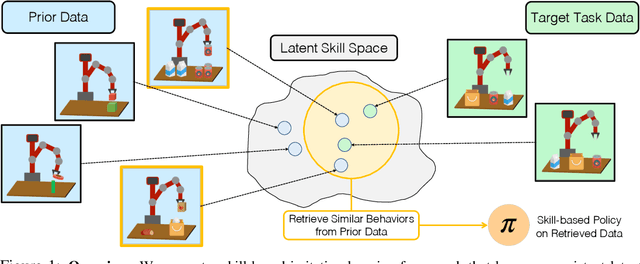

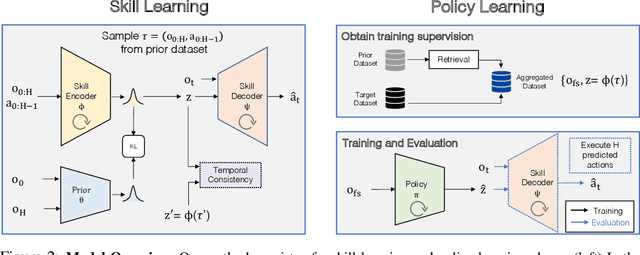

Abstract:Imitation learning offers a promising path for robots to learn general-purpose behaviors, but traditionally has exhibited limited scalability due to high data supervision requirements and brittle generalization. Inspired by recent advances in multi-task imitation learning, we investigate the use of prior data from previous tasks to facilitate learning novel tasks in a robust, data-efficient manner. To make effective use of the prior data, the robot must internalize knowledge from past experiences and contextualize this knowledge in novel tasks. To that end, we develop a skill-based imitation learning framework that extracts temporally extended sensorimotor skills from prior data and subsequently learns a policy for the target task that invokes these learned skills. We identify several key design choices that significantly improve performance on novel tasks, namely representation learning objectives to enable more predictable skill representations and a retrieval-based data augmentation mechanism to increase the scope of supervision for policy training. On a collection of simulated and real-world manipulation domains, we demonstrate that our method significantly outperforms existing imitation learning and offline reinforcement learning approaches. Videos and code are available at https://ut-austin-rpl.github.io/sailor
MineDojo: Building Open-Ended Embodied Agents with Internet-Scale Knowledge
Jun 17, 2022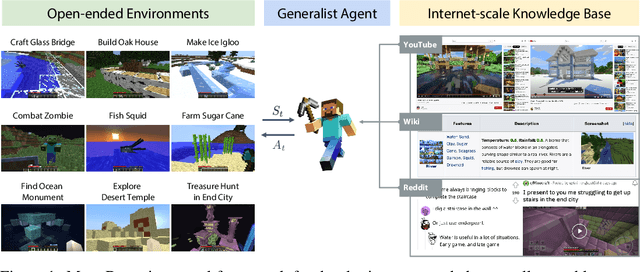
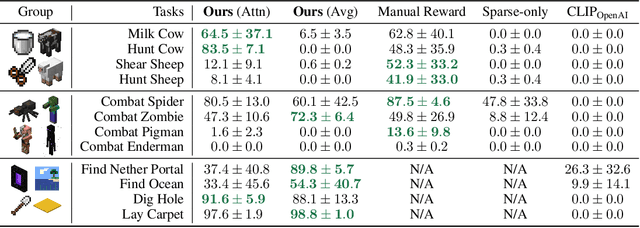
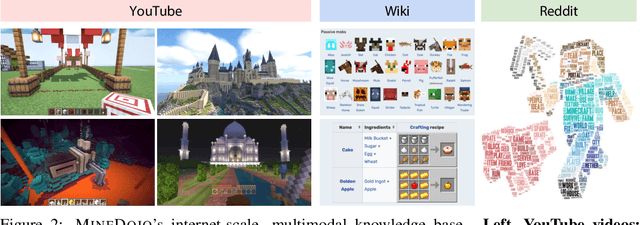

Abstract:Autonomous agents have made great strides in specialist domains like Atari games and Go. However, they typically learn tabula rasa in isolated environments with limited and manually conceived objectives, thus failing to generalize across a wide spectrum of tasks and capabilities. Inspired by how humans continually learn and adapt in the open world, we advocate a trinity of ingredients for building generalist agents: 1) an environment that supports a multitude of tasks and goals, 2) a large-scale database of multimodal knowledge, and 3) a flexible and scalable agent architecture. We introduce MineDojo, a new framework built on the popular Minecraft game that features a simulation suite with thousands of diverse open-ended tasks and an internet-scale knowledge base with Minecraft videos, tutorials, wiki pages, and forum discussions. Using MineDojo's data, we propose a novel agent learning algorithm that leverages large pre-trained video-language models as a learned reward function. Our agent is able to solve a variety of open-ended tasks specified in free-form language without any manually designed dense shaping reward. We open-source the simulation suite and knowledge bases (https://minedojo.org) to promote research towards the goal of generally capable embodied agents.
Error-Aware Imitation Learning from Teleoperation Data for Mobile Manipulation
Dec 09, 2021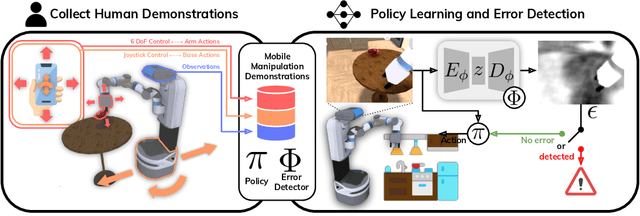


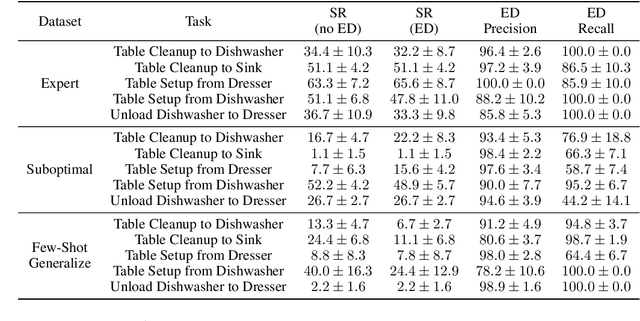
Abstract:In mobile manipulation (MM), robots can both navigate within and interact with their environment and are thus able to complete many more tasks than robots only capable of navigation or manipulation. In this work, we explore how to apply imitation learning (IL) to learn continuous visuo-motor policies for MM tasks. Much prior work has shown that IL can train visuo-motor policies for either manipulation or navigation domains, but few works have applied IL to the MM domain. Doing this is challenging for two reasons: on the data side, current interfaces make collecting high-quality human demonstrations difficult, and on the learning side, policies trained on limited data can suffer from covariate shift when deployed. To address these problems, we first propose Mobile Manipulation RoboTurk (MoMaRT), a novel teleoperation framework allowing simultaneous navigation and manipulation of mobile manipulators, and collect a first-of-its-kind large scale dataset in a realistic simulated kitchen setting. We then propose a learned error detection system to address the covariate shift by detecting when an agent is in a potential failure state. We train performant IL policies and error detectors from this data, and achieve over 45% task success rate and 85% error detection success rate across multiple multi-stage tasks when trained on expert data. Codebase, datasets, visualization, and more available at https://sites.google.com/view/il-for-mm/home.
What Matters in Learning from Offline Human Demonstrations for Robot Manipulation
Aug 06, 2021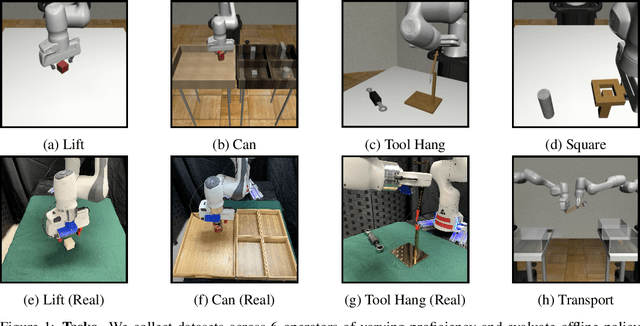
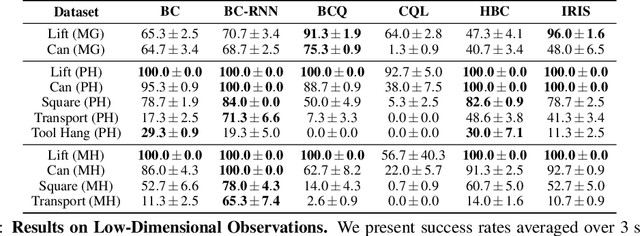
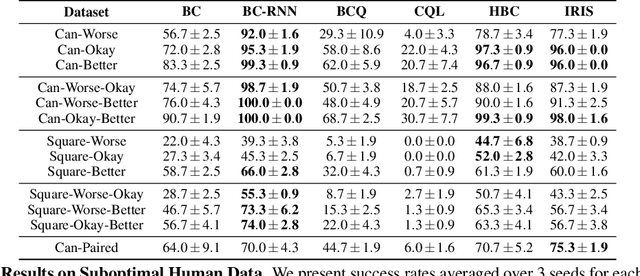

Abstract:Imitating human demonstrations is a promising approach to endow robots with various manipulation capabilities. While recent advances have been made in imitation learning and batch (offline) reinforcement learning, a lack of open-source human datasets and reproducible learning methods make assessing the state of the field difficult. In this paper, we conduct an extensive study of six offline learning algorithms for robot manipulation on five simulated and three real-world multi-stage manipulation tasks of varying complexity, and with datasets of varying quality. Our study analyzes the most critical challenges when learning from offline human data for manipulation. Based on the study, we derive a series of lessons including the sensitivity to different algorithmic design choices, the dependence on the quality of the demonstrations, and the variability based on the stopping criteria due to the different objectives in training and evaluation. We also highlight opportunities for learning from human datasets, such as the ability to learn proficient policies on challenging, multi-stage tasks beyond the scope of current reinforcement learning methods, and the ability to easily scale to natural, real-world manipulation scenarios where only raw sensory signals are available. We have open-sourced our datasets and all algorithm implementations to facilitate future research and fair comparisons in learning from human demonstration data. Codebase, datasets, trained models, and more available at https://arise-initiative.github.io/robomimic-web/
Learning Latent Actions to Control Assistive Robots
Jul 10, 2021
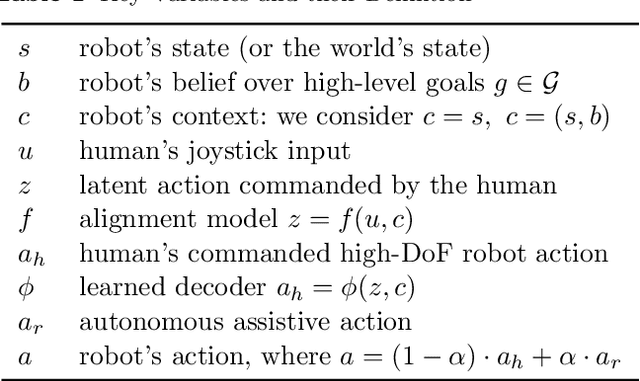
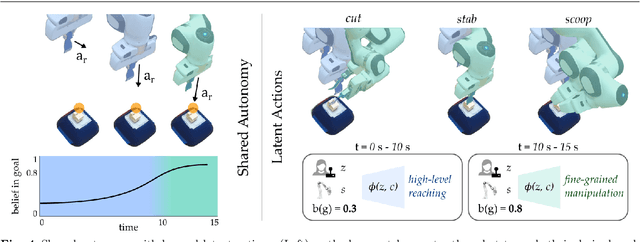
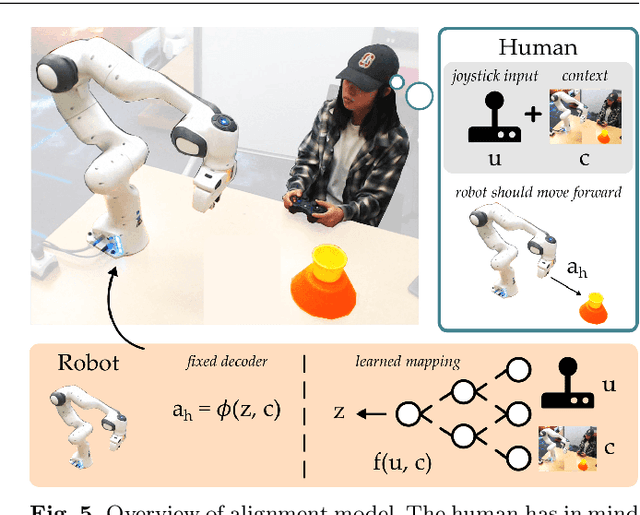
Abstract:Assistive robot arms enable people with disabilities to conduct everyday tasks on their own. These arms are dexterous and high-dimensional; however, the interfaces people must use to control their robots are low-dimensional. Consider teleoperating a 7-DoF robot arm with a 2-DoF joystick. The robot is helping you eat dinner, and currently you want to cut a piece of tofu. Today's robots assume a pre-defined mapping between joystick inputs and robot actions: in one mode the joystick controls the robot's motion in the x-y plane, in another mode the joystick controls the robot's z-yaw motion, and so on. But this mapping misses out on the task you are trying to perform! Ideally, one joystick axis should control how the robot stabs the tofu and the other axis should control different cutting motions. Our insight is that we can achieve intuitive, user-friendly control of assistive robots by embedding the robot's high-dimensional actions into low-dimensional and human-controllable latent actions. We divide this process into three parts. First, we explore models for learning latent actions from offline task demonstrations, and formalize the properties that latent actions should satisfy. Next, we combine learned latent actions with autonomous robot assistance to help the user reach and maintain their high-level goals. Finally, we learn a personalized alignment model between joystick inputs and latent actions. We evaluate our resulting approach in four user studies where non-disabled participants reach marshmallows, cook apple pie, cut tofu, and assemble dessert. We then test our approach with two disabled adults who leverage assistive devices on a daily basis.
Generalization Through Hand-Eye Coordination: An Action Space for Learning Spatially-Invariant Visuomotor Control
Feb 28, 2021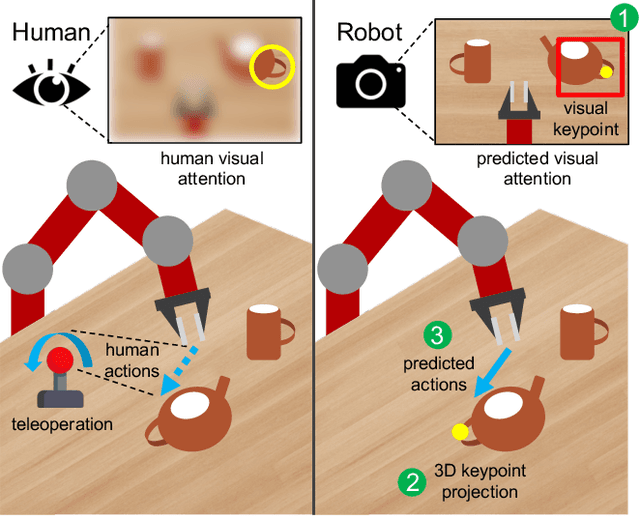



Abstract:Imitation Learning (IL) is an effective framework to learn visuomotor skills from offline demonstration data. However, IL methods often fail to generalize to new scene configurations not covered by training data. On the other hand, humans can manipulate objects in varying conditions. Key to such capability is hand-eye coordination, a cognitive ability that enables humans to adaptively direct their movements at task-relevant objects and be invariant to the objects' absolute spatial location. In this work, we present a learnable action space, Hand-eye Action Networks (HAN), that can approximate human's hand-eye coordination behaviors by learning from human teleoperated demonstrations. Through a set of challenging multi-stage manipulation tasks, we show that a visuomotor policy equipped with HAN is able to inherit the key spatial invariance property of hand-eye coordination and achieve zero-shot generalization to new scene configurations. Additional materials available at https://sites.google.com/stanford.edu/han
Learning Multi-Arm Manipulation Through Collaborative Teleoperation
Dec 12, 2020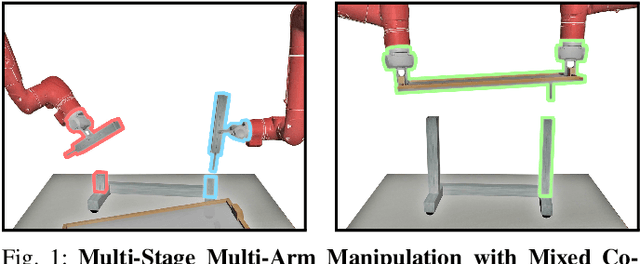
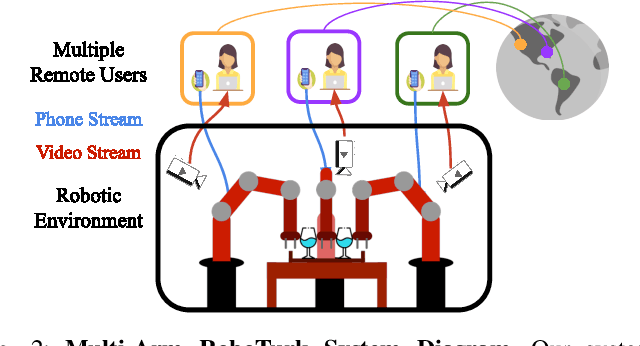


Abstract:Imitation Learning (IL) is a powerful paradigm to teach robots to perform manipulation tasks by allowing them to learn from human demonstrations collected via teleoperation, but has mostly been limited to single-arm manipulation. However, many real-world tasks require multiple arms, such as lifting a heavy object or assembling a desk. Unfortunately, applying IL to multi-arm manipulation tasks has been challenging -- asking a human to control more than one robotic arm can impose significant cognitive burden and is often only possible for a maximum of two robot arms. To address these challenges, we present Multi-Arm RoboTurk (MART), a multi-user data collection platform that allows multiple remote users to simultaneously teleoperate a set of robotic arms and collect demonstrations for multi-arm tasks. Using MART, we collected demonstrations for five novel two and three-arm tasks from several geographically separated users. From our data we arrived at a critical insight: most multi-arm tasks do not require global coordination throughout its full duration, but only during specific moments. We show that learning from such data consequently presents challenges for centralized agents that directly attempt to model all robot actions simultaneously, and perform a comprehensive study of different policy architectures with varying levels of centralization on our tasks. Finally, we propose and evaluate a base-residual policy framework that allows trained policies to better adapt to the mixed coordination setting common in multi-arm manipulation, and show that a centralized policy augmented with a decentralized residual model outperforms all other models on our set of benchmark tasks. Additional results and videos at https://roboturk.stanford.edu/multiarm .
 Add to Chrome
Add to Chrome Add to Firefox
Add to Firefox Add to Edge
Add to Edge